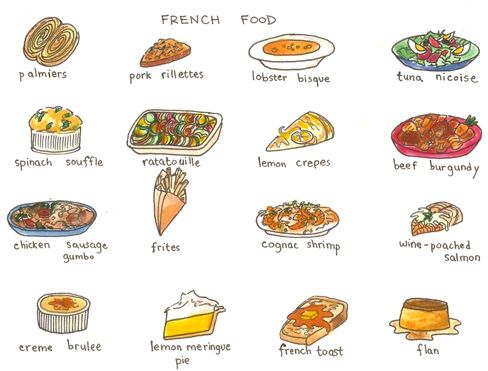A Delicious Guide to French Foods: A Parent’s Primer
Salut Parents! Hungry for knowledge about French cuisine? Then you’ve come to the right place! We’re here to serve up a delightful guide exploring the savory world of French foods. From mouth-watering main courses to delicate pastries that are a treat for the eye, French meals are a feast in every sense! This guide is sure to widen your culinary horizons and shine a spotlight on France’s rich, food-focused culture. So, tighten your apron, preheat your curiosity, and let’s dig in!
Decoding French Eating Culture
Before we dive into the specific dishes, it’s crucial to understand the significance of food in French culture. Away from just satisfying hunger, eating in France is a joyous affair, geared around enjoying the experience and celebrating good company.
The Art of French Meals
French meals often include several courses. Typically, there’s an appetizer (hors d’œuvres), main course (plat principal), cheese (fromages), and dessert (dessert). However, remember, not all French meals are elaborate – simpler fare like croque monsieur also have their place in France’s culinary landscape.
Unveiling Iconic French Foods
Now that we’ve whetted your appetite with a glance at France’s dining culture let’s get to the fun part. Here are a few cornerstone dishes in the diverse palette of French cuisine.
Baguette
No list of French foods would be complete without the baguette. This world-famous bread, long and thin in shape, is an essential part of any French meal, often served along with butter or cheese.
Coq au Vin
Translated to “rooster in wine”, Coq au Vin, is a classic French stew made of chicken slow-cooked in wine with mushrooms, garlic, and onion. This hearty dish exemplifies the French tradition of combining simplicity with incredible flavors.
Ratatouille
Moving onto a vegetarian favorite, Ratatouille is a traditional Provençal stewed vegetable dish featuring eggplant, tomatoes, and zucchini. Bright, hearty, and packed with fresh flavors, it’s a perfect partner for crusty bread or steamed rice.
And that’s just a taste of what French culinary has to offer! Gear up to discover more fabulous French foods in the pages to come, and who knows, you might just find the city of love in a plate near you!

Finishing Your Meal With French Dessert
After devouring savory French meals, it’s time for a sweet ending! The country of love is also a country of divine pastries and desserts. Here are some irresistible options.
Tarte Tatin
A beautiful upside-down pastry, Tarte Tatin is all about caramelized apples baked on a buttery, flaky crust. This classic ‘accidental’ dessert is a testament to the French’s ability to turn simple ingredients into a masterpiece.
Crème Brûlée
Crème Brûlée, translated to “burnt cream,” is a smooth, creamy custard topped with a hard caramel shell. This contrasting texture sensation is an ultimate indulgent treat!
Macarons
These delicate sandwiched cookies are not just cute to look at but are a joy to eat. Crispy on the outside and chewy on the inside, traditional French Macarons come in a rainbow of flavors and colors, making them a favorite dessert for many!
Wrapping It Up
Be it the allure of the baguette and Coq au Vin or the sweet charm of the Crème Brûlée and macarons, you have now taken a quick gourmet tour of some of the quintessential flavors in French cuisine. We hope this guide provides you and your family a fun, edible journey into French food culture. Remember, eating is about more than simply fueling your body, especially in the French culinary world – it’s about sharing, appreciating, and celebrating good food. Bon appétit!
Preparing for Names of French Foods: 5 Essential Facts for Parents
When introducing your children to the exciting culinary world of French cuisine, here are five important factors to remember:
1. Pronunciation
Encourage your children to learn how to pronounce the names of French foods correctly. This enhances their cultural understanding and helps them order confidently in French restaurants. Examples include “Coq au vin” (cock-oh-van), “Ratatouille” (rat-a-too-ee), and “Moules Marinières” (mool mar-in-yair).
2. Cuisine Variety
French cuisine is more than just cheese and croissants. Teach your children about the varieties in dishes from different regions in France. For example, “Bouillabaisse” hails from Provence, while “Choucroute” is a specialty of Alsace.
3. Nutritional Value
Incorporating French food into a balanced diet can be fun and educational. Foods like “Ratatouille” are packed with fresh vegetables, while “Coq au vin” provides good protein sources. Foods like “Croissant” and “Pain au chocolat”, while very tasty, should be enjoyed in moderation due to their higher butter and sugar content.
4. Cultural Context
It’s beneficial to learn about the cultural importance and history behind the food. For instance, the famed “Escargot de Bourgogne” (snails in butter and garlic) is not just a dish, but a cherished tradition in Burgundy.
5. Traditional vs. Modern Cuisine
Not all French food is steeped in tradition. Modern chefs have created fusion cuisines, combining French cooking techniques with international flavors. Discuss both traditional and modern dishes to give the children a broader perspective.
By understanding these aspects, you and your children will be well-prepared to explore the aromatic, savory, and delightful world of French cuisine.
For more great articles please see here. For more information see here
Disclaimer
The articles available via our website provide general information only and we strongly urge readers to exercise caution and conduct their own thorough research and fact-checking. The information presented should not be taken as absolute truth, and, to the maximum extent permitted by law, we will not be held liable for any inaccuracies or errors in the content. It is essential for individuals to independently verify and validate the information before making any decisions or taking any actions based on the articles.




